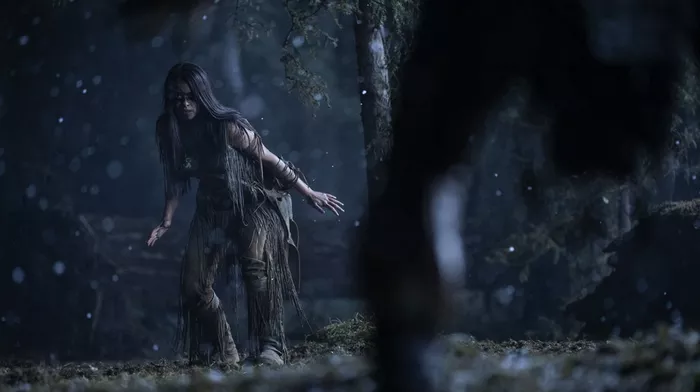“Prey” stands as a unique gem within the beloved Predator franchise, breathing new life into its narrative with a compelling journey into the past and the introduction of a formidable female warrior as its lead. Released on Hulu in August, the movie has received both critical acclaim and positive audience response, boasting an impressive 93 percent approval rating on Rotten Tomatoes. The film’s infusion of cultural depth, emotional complexity, and representation has garnered attention and accolades, making it a noteworthy addition to the franchise’s legacy.
Directed by Dan Trachtenberg, “Prey” follows the young hunter Naru, portrayed by Amber Midthunder, on her quest to confront a powerful Predator. The film diverges from its action-thriller predecessors, opting for a character-driven narrative that explores themes of self-discovery, determination, and resilience. This departure from the norm has not only reinvigorated the franchise but has also earned the film six Emmy nominations, including Outstanding Television Movie, as well as nods for directing and writing.
Interestingly, “Prey” was not initially conceived as a part of the Predator franchise. Trachtenberg shares that his primary focus was on crafting a story centered around an individual striving to prove their worth in the face of challenges. The concept of the Predator emerged as a fitting antagonist for Naru, presenting a compelling conflict that resonates with her journey. Trachtenberg acknowledges that the integration of the Predator IP enriched the movie’s narrative, enhancing its depth and intrigue.
Centering the narrative on Naru allowed “Prey” to adopt a more measured and character-driven approach, distinguishing it from its predecessors. The film delves into Naru’s struggles for recognition within her community, her companionship with her loyal canine companion, and her exploration of her surroundings. These elements contribute to a richer emotional tapestry and set the stage for her ultimate confrontation with the enigmatic Predator.
Reflecting on Amber Midthunder’s impactful portrayal of Naru, Trachtenberg highlights a particularly poignant moment: Naru’s triumphant war cry during the film’s climactic action sequence. Despite battling exhaustion and illness, Midthunder’s commitment and dedication imbued the scene with genuine emotion. Trachtenberg recalls how her raw performance resonates with him to this day, underscoring the authenticity that permeates the film.
Trachtenberg’s creative vision also extended to the design of the Predator itself. Seeking to emphasize the creature’s primal nature, he envisioned a more “feral” appearance. The Predator’s physique was reimagined, featuring a slimmer head and a distinct lack of humanoid characteristics. The innovative design, coupled with the incorporation of skulls infused with advanced technology, contributes to the Predator’s menacing and unsettling presence. Trachtenberg notes that allowing the Predator’s mandibles to remain visible even while masked adds to the creature’s visceral and emotive expressions.
The film’s setting in the past presented Trachtenberg and his team with a fascinating challenge: merging period aesthetics with sci-fi elements. Striking a balance between futuristic weaponry and historical accuracy proved to be an intricate dance. Trachtenberg shares that this challenge extended to the action sequences, which beautifully merge disparate elements. The film showcases the fur trappers’ struggle against the Predator’s onslaught and Naru’s adaptation to the Predator’s weaponry, resulting in dynamic and engaging fight sequences.
One of the film’s noteworthy achievements is its portrayal of the Comanche warriors. Trachtenberg emphasizes the importance of showcasing their resilience and courage, allowing them to leave an indelible mark on their battle against the Predator. Naru’s utilization of her surroundings and her adversaries’ own tools underscores the film’s central theme of leveraging intelligence and resourcefulness to overcome seemingly insurmountable odds.
The film’s historical context also enabled “Prey” to delve into the lore of the Predator franchise. An impactful example is the scene involving skinned buffalo, a nod to the franchise’s iconic imagery. Trachtenberg explains how this scene resonates with the original “Predator” movie and contributes to the film’s cohesive universe.
As for the future of the franchise, Trachtenberg remains tight-lipped about his plans. However, Naru’s journey is far from over. The film’s conclusion sees Naru stepping into a leadership role within her tribe, a role that promises further thrilling adventures. Her evolution from a determined hunter to a capable leader opens the door to a diverse array of narratives.
Trachtenberg is immensely proud of the positive reception “Prey” has garnered. The film’s ability to simultaneously resonate with fans and critics alike is a testament to its success. He views the film as a testament to the potential for genre cinema to be both entertaining and artistically acclaimed. For Trachtenberg, the acknowledgment of peers and the celebration of the film’s emotional resonance serve as the ultimate form of recognition.
“Prey” is now available for streaming on Hulu, offering audiences a captivating blend of history, sci-fi, and dynamic character-driven storytelling.
RELEATED READING:
-
The Diminished Might of Agent Smith: Unraveling the Evolution
-
Revitalizing the DC Universe: Steering Clear of DCEU Mistakes
-
Marvel Villains Whose MCU Origin Stories Outshine the Comics
-
12 Most Powerful Female MCU Heroes Ranked
-
Hobie Brown: The Coolest Character in Spider-Man: Across the Spider-Verse


